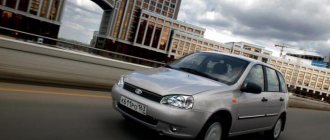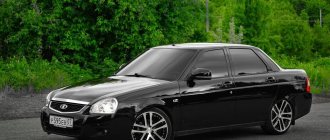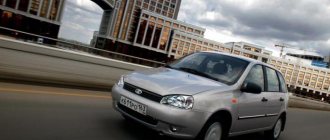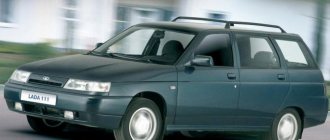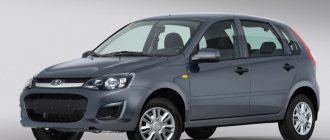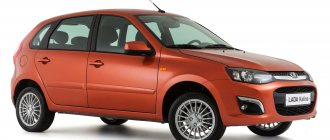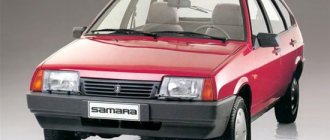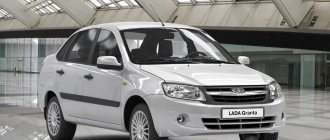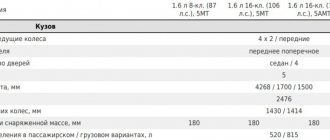Dimensions value
The Kalina family is small but friendly. Some are a little bigger, some are a little smaller, but together they can make it to the parade. The body of the Lada Kalina is made in several modern modifications: sedan, hatchback, station wagon, cross and sport. Their overall dimensions do not vary much.
| Sedan | Hatchback | Station wagon | Cross | Sport | |
| Length, mm | 4040 | 3850 | 4040 | 4104 | 3943 |
| Width, mm | 1700 | 1700 | 1700 | 1700 | 1700 |
| Height | 1500 | 1500 | 1500 | 1560 | 1450 |
| Weight | 1098 | 1098 | 1128 | 1125 | 1150 |
| Base | 2476 | 2476 | 2476 | 2476 | 2476 |
| Clearance | 160 | 160 | 145-160 | 183 | 150 |
The width and wheelbase are the same for all, as it should be for related models. But the length, height and ground clearance are different. Accordingly, the volumes and masses are different. The history of Lada models has seen long stagnation and a period of failure. In 2004, the release of the first Kalina from the assembly line ushered in a new era. Since then, new items appear almost every season, and the ranks of owners of the most popular car in Russia are growing from year to year.
The geometric dimensions of the body are important, but no less interesting is the volume of the trunk. All Kalina models are designed to allow the rear seats to be folded forward and increase luggage compartment space. The most voluminous trunks are for the sedan, station wagon and cross: 355/670 liters. “Hatchback” and “sport” are more modest - 240/550 hp. It’s also not bad, as many city car owners will agree with.
In the ranks of Kalina there is another model - Lada Kalina City (Oka-3), made on the VAZ-1117 platform. It appeared in 2005 and for some time was considered a replacement for the Oka small car, but this assumption is incorrect. It has almost the same dimensions, height and width as other Kalinas, only the length is 3650 mm. The result was a version of the Kalina hatchback, shortened by 20 cm and correspondingly lighter in weight - 980 kg. Next to the miniature Oka it looks incomparably larger. "Kalina City" is not widely used, but it can still be found on Russian roads.
There is another dimensional indicator that is rarely interested in until they get stuck in a rut. At this point, some people discover the fact that the distance between the front wheels is different from the distance between the rear. This parameter is called: front and rear wheel track. For the “sedan” and “hatchback” with “station wagon” - 1430/1414 mm, for the “sport” - 1431/1432 mm and for the “cross” - 1430/1418 mm.
The difference in millimeters may not be noticeable to the eye, but it is easy to feel when a few millimeters are not enough to get out of an icy rut on a winter road. The track size turned out to be wrong.
All-wheel drive Kalina capabilities
New crossover Kalina
Passenger cars with all-wheel drive have been rapidly gaining popularity recently. This is largely due to the fact that alternative crossovers began to be content with front-wheel drive, and their purpose as off-road vehicles became more than blurred. By equipping a passenger car with all-wheel drive and adding several off-road accessories, you can significantly increase the capabilities of the car without overpaying for status.
Many global companies have taken the path of equipping their passenger models with all-wheel drive. AvtoVAZ is also trying to keep up in this direction, offering customers the all-wheel drive Kalina. What abilities did the car acquire with such equipment and has the functionality of the car really increased? It's worth looking into this.
A new generation is replacing
In 2013, Russian roads welcomed the new Lada-Kalina 2 model. It immediately caught the fancy of those who were passionate about VAZ products, and began to win new fans. In terms of body models, Kalina 2 is currently limited to hatchback and station wagon.
They repeat their predecessors in height 1500 mm, ground clearance 210 mm, wheelbase 2476 mm and track: rear 1414 mm / front 1431 mm.
Other dimensions are not the same. Body control dimensions show:
- “hatchback” - length 3893 mm and width 1700 mm;
- “station wagon” - 4084 mm and 1539 mm;
- The trunk volume is the same - 260/361 liters.
Nothing in the world is perfect, there will always be critics and detractors. Nevertheless, even a cursory glance at what ordinary users write, sharing their impressions without the goal of advertising anyone, confirms: “Lada-Kalina 2” is a good city car. If we add to the above such important parameters as “price - quality” and “gasoline consumption in the city”, then it can be considered one of the leaders in its market segment.
The same opinion can be heard in any “garage fraternity”, where they express themselves artlessly, but with knowledge of the matter. Popular approval has been received, as has the expectation of new models.
tweet
back Lada Kalina: characteristics of the model with a gun
Forward What kind of instrument panel does Kalina have?
Tags: trunk, overall dimensions, ground clearance
Main parameters and characteristics of the engine
VAZ-21114-50; VAZ-21114-90:
- Modifications of Lada-Kalina: VAZ-11173, VAZ-11183, VAZ-11193;
- Engine type: four-stroke, gasoline, with spark ignition and fuel injection system;
- Number of cylinders - 4;
- The cylinder arrangement is in-line;
- Cylinder diameter - 82 mm;
- Piston stroke - 75.6 mm;
- Cylinder displacement - 1.596 l;
- Power system - multipoint injection;
- Ignition system - electronic distributed type;
- Rated power - 59.5 kW;
- Rated crankshaft rotation speed - 5100-5300 rpm;
- Maximum torque - 120 Nm (at 2800-3200 rpm);
- The minimum crankshaft rotation speed at idle is 800-850 rpm;
- Fuel - gasoline "Premium-95" GOST R 51105-97.
VAZ-11194:
- Modifications of Lada-Kalina: VAZ-11174, VAZ-11184, VAZ-11194, Lada-Kalina Sport (1.4);
- Engine type: four-stroke, gasoline, 16-valve with spark ignition and fuel injection system;
- Number of cylinders - 4;
- The cylinder arrangement is in-line;
- Cylinder diameter - 76.5 mm;
- Piston stroke - 75.6 mm;
- Cylinder displacement - 1,390 l;
- Power system - multipoint injection;
- Ignition system - electronic distributed type;
- Rated power - 65.5 kW;
- Rated crankshaft rotation speed - 5500-5700 rpm;
- Maximum torque - 127 Nm (at 4200-4800 rpm);
- The minimum crankshaft rotation speed at idle is 810-870 rpm;
- Fuel - gasoline "Premium-95" GOST R 51105-97.
VAZ-21126:
- Modifications of Lada-Kalina: Lada-Kalina Sport (1.6);
- Engine type: four-stroke, gasoline, 16-valve with spark ignition and fuel injection system;
- Number of cylinders - 4;
- The cylinder arrangement is in-line;
- Cylinder diameter - 82 mm;
- Piston stroke - 75.6 mm;
- Cylinder displacement - 1.597 l;
- Power system - multipoint injection;
- Ignition system - electronic distributed type;
- Rated power - 72 kW;
- Rated crankshaft speed - 5600 rpm;
- Maximum torque - 145 Nm (at 4000 rpm);
- The minimum crankshaft rotation speed at idle is 850 rpm;
- Fuel - gasoline "Premium-95" GOST R 51105-97.
Fuel consumption and dynamic characteristics: VAZ-11183, VAZ-11193
- Engine: VAZ-21114 (Euro-3);
- Fuel consumption (combined cycle) - 7.8 l/100 km;
- Maximum speed - 170 km/h;
- Acceleration time to 100 km/h is 13 s.
Fuel consumption and dynamic characteristics: VAZ-11184, VAZ-11194
- Engine: VAZ-11194 (Euro-3);
- Fuel consumption (combined cycle) - 7.0 l/100 km;
- Maximum speed - 165 km/h;
- Acceleration time to 100 km/h is 12.2 s.
Fuel consumption and dynamic characteristics: Lada-Kalina Sport (1.4):
- Engine: VAZ-11194 (Euro-3);
- Fuel consumption (combined cycle) - 7.0 l/100 km;
- Maximum speed - 165 km/h;
- Acceleration time to 100 km/h is 12.2 s.
Fuel consumption and dynamic characteristics: Lada-Kalina Sport (1.6):
- Engine: VAZ-21126 (Euro-3);
- Fuel consumption (combined cycle) - 7.8 l/100 km;
- Maximum speed - 170 km/h;
- Acceleration time to 100 km/h is 11 s.
Vehicle configuration
Inside the car
The Lada Kalina family was created on the VAZ 2108 platform. The progenitor of the new model received a significantly redesigned chassis, as well as the layout of the power unit and transmission. The angular shapes completely disappeared from the exterior; in general, it could be called modern and inviting. All hard plastic parts have been removed from the interior. The panels became soft and warm, this was especially noticeable in cars produced in 2010-2013. In general, a description of all the changes that the mother platform has undergone can take several pages, so let’s note the main thing: the car has become many times more convenient and safer than the Lada Samara.
Lada Kalina with 4x4 all-wheel drive
You think that sticking a plastic body kit and putting high tires on modifications of Lada station wagons was invented recently, with the advent of the word “Cross”. In fact, the first Lada Kalina Cross station wagon should have appeared back in 2007. At the same time, Avtovaz planned to launch not only front-wheel drive pseudo-crossovers, but also Lada Kalina 4x4
with all-wheel drive. The most interesting thing is that the transmission has already been manufactured and tested.
the Lada Vesta Cross today
turning the model into a full-fledged SUV with an incredible design. But as often happens, the developments of domestic engineers never reach serial implementation.
Why was all-wheel drive needed?
All-wheel drive transmission of the new Kalina
When you start getting acquainted with the all-wheel drive Kalina, you involuntarily notice that there was no official information on this matter. The classic all-wheel drive for a passenger model is clearly not suitable in this case. AvtoVAZ has not used all-wheel drive before, and most likely does not have its own developments. Fragmentary information dates back only to 2006.
Using a simplified version with a locking clutch does not pose a big problem for implementation. But the use of various electronic systems as a 4x4 pseudo-drive requires serious development, so it could not appear like that, right away.
And yet, the Lada Kalina 4x4 was created at one of the Tolyatti enterprises. In this case, three conclusions immediately arise:
- work on an alternative all-wheel drive is still underway at the plant;
- AvtoVAZ plans to expand the market by conquering new niches;
- New faces appeared in the company, for example, a Swedish specialist in the place of director and marketer.
These three components allow us to look into the future. Firstly, all-wheel drive is no longer seen as the only reason that gives the car the opportunity to increase cross-country ability. In the developments of all-wheel drive on a passenger car, you can see the more confident behavior of an active hatchback on the highway. Secondly, do not forget the announced appearance of the Lada XRay in 2016.
"Priora" or "Kalina": classification problems
The word “problem” will generally accompany us throughout the text, and it begins already when determining what is in front of us.
Formally, Kalina is a European B-class, Priora is closer to a C-class. In fact, the difference in dimensions is nominal:
- top-end Kalina station wagon - 4.11 m in length;
- Priora with the same body type - 4.21 m.
At the same time, it is absolutely unclear where the extra decimeter of space went.
In terms of the amount of space in the cabin, it is also unclear which class is which: low seating, minimal gap between the rows of seats - in both cars only short and hardy people can sit in the back for a long time. That is, Mongolian steppe riders.
And it’s even funnier that in both Kalina and Priora, the body type has almost no effect on anything. It’s usually the same: a sedan has a spacious, but most inconvenient trunk, a station wagon is the opposite: it has the maximum displacement and ease of use.
What about LADA? The trunk of a station wagon is not the most spacious, but the most spacious is that of the Granta co-platform liftback (after restyling, this became one family, which makes it even funnier).
The Priora has no difference at all in terms of practicality between body types: both the liftback and the station wagon have 360 liters each behind the rear sofa.
In short, the difference is purely aesthetic. There is no point in looking for a “Kalina station wagon” or a “Priora station wagon” in the hope of seeing space and capacity there.
Also read: Focus on Priora or priority on Accent? Comparing two budget bestsellers
Modifications of Lada Kalina 1119
The hatchback model was produced in our country from 2006 to 2013 without any changes.
There were two manual transmissions, but there were four power units to choose from:
We have separate detailed material on all Kalina power units on our website.
2011 Lada Kalina. Review (interior, exterior)
Description of main faults
On Kalina, with regard to power units, there are a number of constant malfunctions. Why are they considered permanent? Most likely, this is due to design flaws that the designers cannot correct. So, let's look at which faults are more common than others.
The engine gets hot
The cause of this phenomenon is often the thermostat. As everyone knows, this is a common occurrence on cars produced by AvtoVAZ, starting with the “Classics”. To eliminate the problem, you need to replace the thermostat with a new one. But what to do if the reason is not in it, and the engine was heating up for another reason? It is worth determining why this is so and what the reasons are.
- Temperature sensor malfunction.
- The cooling fan has failed.
- Faulty wiring or electronic engine control unit.
Failure to comply with the temperature regime can lead to engine malfunction, and will also lead to significant malfunctions of the cylinder head and cylinder block. It is worth remembering that the recommended operating temperature of the Kalina engine is 87-103 degrees Celsius.
To ensure that the car does not heat up above the recommended values, it is necessary to check whether the cooling system and other related components are working properly.
"Kalina" or "Priora": what about the equipment?
Until the second half of the 2000s it was very bad. AvtoVAZ is slow to introduce innovations, so their cars reached more or less European levels (early 90s) only in 2013. It was then that both Kalina and Priora received (all or separately) airbags, ESP, heated windows, air conditioning, automatic transmission (Kalina), a media system with navigation and support for SD cards.
Everything before 2013 is pain, poverty and mud: the list of options included ESD (periodically jamming) and ABS.
The restyling of the 13th year also had a positive effect on the visual component: the plastics are still just as cheap, but at least the parts are neat; The climate control unit, for example, has become similar to a Volkswagen one from the early 2000s. Which is actually a compliment.
So it doesn’t matter what to watch - Kalina or Priora, as long as it’s after the 2013 release.
Also read: Which is better: “Granta” or “Kalina 2”
Exterior and interior of the crossover
And yet the Lada Kalina 4x4 stands out. It’s worth mentioning right away that this is still a piece product. But at least the car can already be assessed from the photo. If it appears on the assembly line, it will have many competitors. After all, among all-wheel drive passenger cars there are several charged hatchbacks. Similar cars are also in the arsenal of such manufacturers as Opel, Ranault, Subaru and other companies. Moreover, Subaru is the clear favorite here, having long and glorious traditions. New photos of Lada can be found on various sites.
A little more about all-wheel drive
Using a center differential is not a new idea for all-wheel drive. A special feature of a device such as a differential is the transmission of torque to different wheels at the desired angular speed. However, this mechanism redistributes the torque to the wheel that currently has the least resistance. Therefore, the center differential will not work normally to provide pure all-wheel drive to the vehicle. If one of the wheels gets into lighter conditions, it will receive all the torque.
Therefore, the Kalina design with all-wheel drive received such an additional device as a viscous coupling. The peculiarity of the coupling's operation is related to the properties of the silicone liquid filling its internal space. It becomes liquid when cooled and thickens when heated.
The percentage of torque transmission under normal conditions does not exceed 7-10%. When the discs rotate with a lag, the liquid heats up and thickens, gradually closing the discs forcibly, and torque is transmitted with forced distribution along the axes. In this case, the clutch reacts sharply to changes in the angular speeds of the wheels, since the drive shafts rotate faster than the wheels themselves.
It should be borne in mind that this method, used on Kalina with all-wheel drive, is more suitable for road cars. Off-road, where conditions for the drive wheels are constantly changing, the clutch mechanism gradually wears out as it overheats. The coupling quickly fails.
Why did it happen so?
Perhaps the automatic requests do not belong to you, but to another user accessing the network from the same IP address as you. You need to enter the characters into the form once, after which we will remember you and be able to distinguish you from other users exiting from this IP. In this case, the page with the captcha will not bother you for quite a long time.
You may have add-ons installed in your browser that can make automatic search requests. In this case, we recommend that you disable them.
It is also possible that your computer is infected with a virus program that is using it to collect information. Maybe you should check your system for viruses.
If you have any problems or would like our support team, please use the feedback form.
This is the Lada model
The Lada Kalina station wagon (factory code VAZ 1117) appeared on the country's roads in early 2007. This car was developed on the basis of the VAZ 1118 sedan, which entered the market 3 years earlier. Like all cars of this model range, Kalina 1117 was created for intensive driving in urban conditions and, depending on the configuration, was equipped with 2 different injection engines, which provided the car with excellent dynamics. Despite similar speed and technical characteristics, the station wagon had a number of advantages compared to a hatchback car. Firstly, it was 19 centimeters longer, which significantly improved the comfort of rear seat passengers and increased the volume of cargo carried. Secondly, the station wagon’s ground clearance is 2.5 cm higher, which ensures better cross-country ability on snowy and dirt roads.
During the production process, the machine was constantly modernized. In 2010, buyers were surprised by the new interior design. In 2011, the car began to comply with EURO 4 environmental standards and received an electronic gas pedal. But despite constant updates, in the spring of 2013 the 1st generation station wagon was discontinued.

